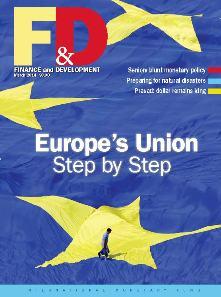
Typical street scene in Santa Ana, El Salvador. (Photo: iStock)
IMF Survey : European Integration, Step by Step, Focus of Latest F&D Magazine
February 27, 2014
- More integration critical to region’s success, says IMF’s Reza Moghadam
- Without stronger center, euro in danger, argues Oxford’s Kevin O’Rourke
- Banking union, jobs and growth essential for resolution to European troubles
The latest issue of the IMF’s magazine, Finance & Development (F&D), focuses on Europe’s drive toward economic integration—the forces bringing it together and those pushing it apart, with contradictory views on how this can work.

A large European Union flag in front of Romania's Parliament Building marks EU Day in Bucharest (photo: Bogdan Cristel/Reuters/Corbis)
REGIONAL OUTLOOK
Over 20 million people in the euro area, or 12 percent of the population, were out of work at the end of 2013, and output was 3 percent below that at the start of the crisis. “Europe is in a terrible mess,” says Oxford University’s Kevin O’Rourke in the March 2014 issue of F&D.
O’Rourke sees this as evidence of a dismal policy failure largely due to the limits that monetary union puts on policymaking. He says Europe is now “defined by the constraints it imposes on governments, not by the possibilities it affords them to improve the lives of their people.” The solution is either a federal political Europe, or a European Union without a single currency. “If a crisis is inevitable, then it is best to get on with it, he says.
But the latest IMF World Economic Outlook Update says the euro area is turning the corner from recession to recovery. Growth is projected to strengthen to 1 percent in 2014 and 1.4 percent in 2015, though the recovery will be uneven and countries that have been under stress will see a more modest pickup. High debt, both public and private, and financial fragmentation will hold back domestic demand, while exports should further contribute to growth. Growth in central and Eastern Europe is projected at around 3 percent.
Reza Moghadam, head of the IMF’s European Department looks back at Europe’s experience, and concludes that the commitment to closer ties runs deep. And yet economic, financial, and fiscal integration remains incomplete. That deficiency was the root cause of the euro area’s recent debt crisis and reinforced its severity. The answer, says Moghadam, is more integration, not less.
The global financial crisis exposed weaknesses in the region’s supranational structures and eroded political support for closer ties, writes Moghadam. But integration has yielded substantial benefits for Europe, and 25 years after the fall of the Berlin Wall it continues to be the best way forward for the region.
Moghadam notes that “the nascent recovery in the euro area risks creating complacency—a wrongheaded belief that the crisis is over and integration efforts can be relaxed.” Resolution of the crisis calls for stronger institutions underpinning the euro area and a better understanding of how countries affect each other. A more robust euro area will prevent country-specific shocks from spilling over to the rest of the region.
“If political will can once again be summoned, further integration coupled with steps to boost growth can create a more durable foundation for prosperity in the region,” concludes Moghadam.
Other articles on Europe include:
Banking union is a long-term process that will profoundly reshape Europe’s financial system
Nicolas Véron
Conquering unemployment and boosting growth is the number one priority in Europe today.
Helge Berger and Martin Schindler
The continent has set ambitious goals for reducing carbon emissions. This requires large-scale deployment of low-carbon energy sources, a single market for energy, and use of gas as a backup fuel
Laszlo Varro
European soccer’s success can be credited, in part, to the liberalization of the players’ market. But what will the future bring?
Stefan Szymanski
Jeremy Clift profiles Lucrezia Reichlin, former Chief Economist at the European Central Bank and a pioneer of real-time short-term forecasting.

â– Also in this issue, Eswar Prasad explains why the dollar is unlikely to be dethroned anytime soon as the global reserve currency. IMF economists Nicole Laframboise and Sebastian Acevedo write about how countries can use monetary policy to fight against the ravages of natural disaster. And we look at the effect of aging on monetary policy in advanced economies, and how changes in asset prices can help economists predict economic downturns.







